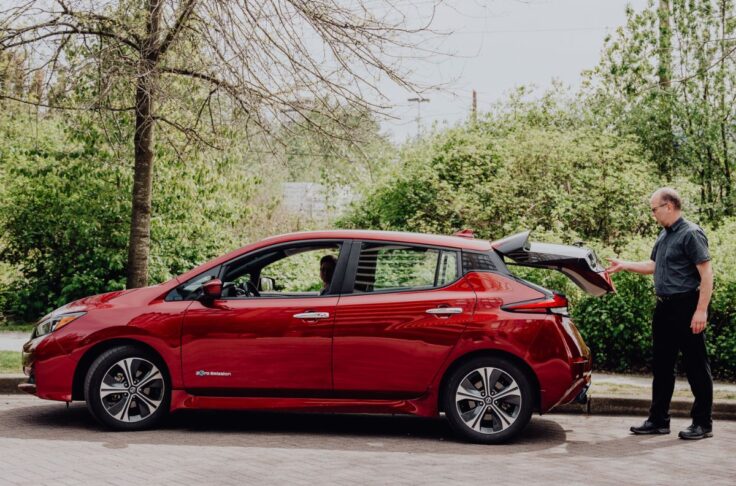The Future of Shared Mobility – Lessons from Fluctuo
Summary
In our latest “Lessons from” interview, we spoke with Julien Chamussy, CEO of Fluctuo. Paris-based Fluctuo collects and interprets trip data from all shared mobility modes all across Europe, North America and Oceania. Additionally, the company publishes an amazing quarterly insights report, called the European Shared Mobility Index. We talked with him about how the total number of trips in Europe changed, how central KPIs like trips per day per vehicle developed, and how the demand for carsharing has increased in recent years.

You collect European trip data from shared mobility operators: Can you compare your historic aggregated vehicle mode data for Europe for us?
Shared mobility is very seasonal, but has rebounded well from the heavy impact of Covid-19 in 2020 and some of 2021. Below is a graph that shows the continued growth of shared mobility across 16 key cities in Europe.

The graph shows a 28.5% growth in ridership (the total number of trips/rides) in 2022 versus 2021. Ridership more than doubled in Prague, Rotterdam and Rome from 2021 to 2022, whilst Stockholm saw 5 times as many trips – largely thanks to the reversal of the ban on kickscooters.
How did the number of trips per vehicle per day (TVD) of different shared mobility modes develop in the past?
Since 2018, nearly 600,000 dockless kickscooters, bikes and mopeds have been deployed across the continent, taking the total to 850,000 shared vehicles by the end of 2022.
Broadly speaking, Fluctuo found the number of trips per vehicle per day in Europe, across all modes, to be 1.9.
Across the key 16 cities in the European Index monitored, the number of trips per vehicle per day in 2021 was 3, and in 2022 it was 2.9.
Here’s how often each vehicle was used per day per mode in 2022:

What are outstanding aka best-practice TVD (trips per vehicle per day) for your different vehicle mode classes?
Cars
Shared cars are slightly different from the other shared mobility vehicle types as cars can be rented either by the minute or by hour or day. If a car is reserved for a day rental, the maximum number of trips that that car can do in one day is (theoretically) one. Cars in Hamburg, where free-floating carsharing by the minute is very popular hauled in 3.2 trips per car per day across 2022. We must also bear in mind that TVD is not necessarily the best metric to judge the success of carsharing. Total rental time (the percentage of the time in a day or month that the car is being rented) as well as the revenue per hour rented are the most important metrics to take into consideration.
Mopeds
Due to the fact that mopeds have longer average trip lengths than bikes and scooters, they are used less frequently. This is also because they are larger vehicles, and less common than bikes (with a few exceptions). Moped use grew by 0.3 trips per vehicle per day, showing that demand is growing and fleet sizes are becoming more optimal. Mopeds in Bordeaux averaged 3.3 trips per vehicle per day in 2022, Barcelona 2.5, and Rotterdam 2.9.
Bikes
Paris and Barcelona are home to two of the largest and most successful bike sharing services in Europe. Docked and dockless bikes in Barcelona had an average of 7.2 trips per bike per day in 2022. The second closest is Paris with 4.8. Barcelona has a milder climate during winter months so trips don’t fall as much as they do in the French capital. The other important factor is that there are no shared scooters in Barcelona. So any would-be shared scooter users may well have been converted to using bikes (or mopeds). Only time will tell if the same trend will be seen in Paris from September 2023 once scooters are removed from the city.
Kickscooters
Oslo and Bordeaux are great success stories for shared kickscooters. Both are cities that introduced tenders to clean up the kickscooter landscape. Oslo had over 15,000 kickscooters in the city, before a tender enforced a fleet cap of 6,000 (2,000 per operator). Bordeaux had 6 operators each operating a maximum of 100 vehicles – now two operators operate 2,000 kickscooters each.
How did the demand for carsharing change over the past year?
Although the TVD for shared cars in the 16 cities above remained steady, we saw a growth in ridership across Europe. There was also an increase in carsharing fleets launched across the continent. Demand for carsharing services is picking up – especially free-floating schemes. In 2022, we tracked 65,000 shared cars that produced a 26% growth in ridership compared to 2021.
Some experts talk about market consolidation: Is it a buzzword or reality?
Consolidation in any industry is a given. In 2020 there was a first phase of consolidation, with many companies being acquired (e.g. Spin). Nextbike and PBSC were both acquired in the last two years by TIER and Lyft respectively. Despite the concern over profitability, over €250m was raised between June 2022 and June 2023. Cabify €140m, Cooltra €25m, Human Forest €13.6m, Cargoroo €10m. Showing that there is real support for operators that are building sustainable services. In carsharing, we saw more takeovers, with MILES acquiring WeShare in Q4 2022 as well as Norwegian operator Hyre taking over Danish operator LetsGo.
As tender processes tighten up, there will be fewer opportunities for operators to win markets. Some markets are also over-regulated, making it difficult for operators to run sustainable operations.
How does local market consolidation impact the utilization rate of remaining operators?
Usually, reducing the number of operators improves the TVD of the remaining operators. This is usually because the fleet sizes for the remaining operators are increased. They are able to capture a larger market share than before. We previously discussed the cases of Oslo and Bordeaux, how they reduced the number of operators and created ideal conditions for the chosen operators to be successful.
Looking into the crystal ball, what will the future of shared mobility industry look like in 2 and 20 years?
In 2 years
I expect the landscape to look more or less the same as it does today. There will be fewer players (due to consolidation and the generalization of tenders). The total number of vehicles should be stable in the largest cities, with a significant increase in mid-size cities. Ridership will increase, but largely due to a higher TVD, rather than the deployment of more vehicles.
In 20 years
As far as micromobility is concerned, in the largest European cities, there won’t be more vehicles than today, but the TVD will be three times higher because:
- Vehicles will be more robust
- Battery improvements and innovation will bring more capacity (at least 150km per charge)
- Universal docking/charging stations and self-service battery-swapping infrastructures will be implemented to serve all types of micromobility vehicles (shared and owned)
The biggest potential, in my opinion, lies with carsharing. Restrictions on ICE (internal combustion engine) cars in metropolitan areas will be progressively put in place (urban road tolls, congestion charges or Low Emission Zones, if not wholesale bans of these vehicles) and, as electric cars might still be quite expensive, shared cars will be a popular alternative.
Shared cars will also be more frequently used by tourists or people on holiday. They will progressively opt for taking the train over driving their own car to their summer destination. With that, we will see the lines that have begun to blur between regular car rental and carsharing today, will have disappeared completely.
Can you give us some examples of how the shared mobility transition can be supported to flourish further and faster?
The three most important parts of making shared mobility flourish are unit economics, safety, and convenience. To speed up the transition to shared mobility, we need to prove that it can be economically viable. Today, operators are searching for profitability and I believe that is coming soon. Once we know that services can be profitable and there is a model that works, the transition will come naturally. When speaking specifically about carsharing, there must be a willingness from cities to make concessions on shared car parking, instead of charging higher parking fees than what private car owners have to pay for on-street parking. This will make carsharing more profitable and make it easier to run economically viable schemes.
However, a big part of the equation is the safety of riders and citizens. Whilst vehicles are getting safer and safer, there is still a way to go. We need to convince all public authorities that shared services are beneficial to the urban mobility landscape. The question marks over free-floating micromobility and parking is the standout issue.
Finally, the growth of shared mobility will be down to how convenient it is for the end-user. If we are too rigid on when vehicles can be dropped, it will not be as practical as taking a private car that you can park in your driveway/on the road outside your house. To really accelerate the transition, we must think of new ways that users can use a bike, kickscooter, moped, or shared car in a way that makes it more convenient for them than their car.
Thank you Julien for the interview and valuable insights on the future of shared mobility!
If you like to gather more information on trends in the shared mobility industry, check out our reports and webinars.


